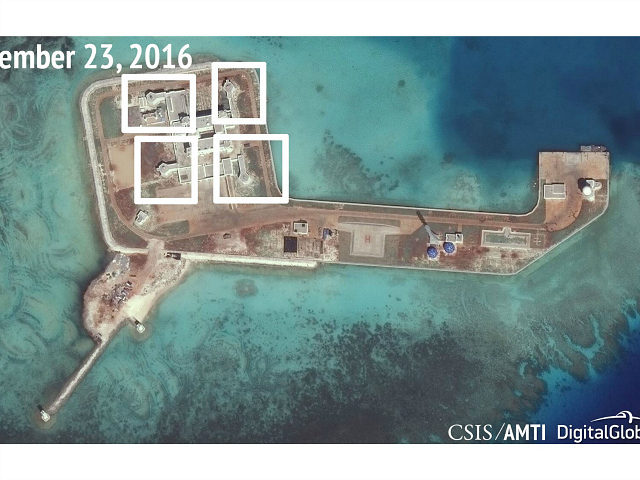The Chinese government appears to have accelerated its development of military assets in the South China Sea’s Spratly Islands, a territory claimed by the Philippines and Vietnam.
Citing new satellite images, the Center for Strategic and International Studies (CSIS) reports that China appears to have installed “large anti-aircraft guns and probable close-in weapons systems (CIWS)” in the Spratly island chain. The photos track the development of construction on four of the islands in the chain, which all appear to boast some kind of military asset.
On some, CSIS notes that the nature of the military assets is clear, while on others, difficult-to-identify “objects without clearly visible barrels” can be seen. “These cannot be definitively identified, but are likely CIWS to protect against cruise missile strikes,” the organization notes.
“These gun and probable CIWS emplacements show that Beijing is serious about defense of its artificial islands in case of an armed contingency in the South China Sea,” CSIS concludes, adding that these appear to be in part “the last line of defense against cruise missiles launched by the United States.”
China has been developing military assets on the Spratly and Paracel island chains for years, despite the fact that these are in international waters and claimed by neighboring countries. Chinese officials have previously maintained that the facilities on these islands were strictly civilian, however, intended to track climate change and deploy rescue missions for wayward maritime vessels.
Beijing has regularly maintained that most of the South China Sea is exclusive Chinese territory due to “ancient” claims, though six other nations claim parts of the sea: Brunei, Taiwan, Malaysia, Indonesia, Vietnam, and the Philippines. As China does not recognize Taiwanese sovereignty, it has asserted that any Taiwanese claims are actually China’s.
Despite the more overt military functions of its new assets in the Spratly Islands, the Chinese Foreign Ministry once again said in a statement responding to the CSIS report that its constructions are “mainly for civilian use,” though ominously adding, “If someone makes a show of force at your front door, would you not ready your slingshot?”
In a separate statement, Reuters notes, Chinese Foreign Ministry spokesman Geng Shuang referred to the military facilities as “normal” and condemned freedom of navigation exercises on the part of the United States and other powers. “The Nansha [Spratly] islands are China’s inherent territory. China’s building of facilities and necessary territorial defensive facilities on its own territory is completely normal,” he said.
In remarks earlier this week, U.S. Pacific Command head Admiral Harry Harris warned that China had become increasingly “assertive” in the South China Sea and that the U.S. military would inevitably have to respond to Beijing’s belligerence.
“We will not allow a shared domain to be closed down unilaterally no matter how many bases are built on artificial features in the South China Sea,” he said in Sydney, where he also announced that a concerned Australia would allow the U.S. to fly missions out of using its most highly-developed fighter aircraft.
“I’ll be blunt in saying that the global operating system that created the Indo-Asia-Pacific economic miracle is coming under pressure from revisionist powers,” he said, adding that there was “no room for subtlety” in challenging China and a “revanchist” Russia.
The Global Times, a Chinese propaganda outfit that often publishes some of the more militaristic and anti-American opinions in Chinese media, immediately pounced on Harris’s statements. “Harris is perhaps the most senior US military leader to have regularly spoken such tough rhetoric against China in the past years,” a column published following his statements argues. “Because of this high frequency, Chinese people have grown numb to his words, including his talk about how his forces must be ready ‘to fight tonight.'”
“It’s legitimate and reasonable for China to deploy defensive weapons on its own islands. It doesn’t need to ask for anyone’s permission,” the Times continues. “It is the US that has been flexing its muscles by deploying 14 F-22 jets to Japan previously and then to Australia. The Pentagon has never bothered to ask for Beijing’s permission in advance.”

COMMENTS
Please let us know if you're having issues with commenting.